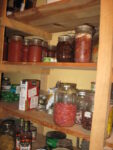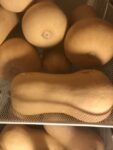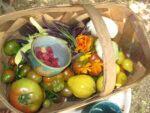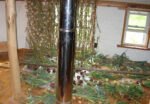A version of this column first ran in the Roane County (WV) Reporter and Times Record as part of a gardening series. Support local journalism! Subscribe to your local newspaper. This is one of a series of blogs for new gardeners. Start reading the whole series here: Part 1.
Now that it’s May, and we can almost count on no more frosts…what sorts of garden activities can you expect? You may want to be gradual about planting the tender items, as it has been known to frost in May around here. It’s unlikely to go below about 29 degrees, though, which means you can cover tender plants and they’ll come through a frost without harm. So maybe limit yourself, for awhile, to the number of tender plants for which you have covers.
Other weather conditions are important now. As I write this (last week), on a rainy day, the forecast is calling for a couple of sunny days and then a week of mostly cloudy, showery weather. I’ll want to plant carrots just before that cloudy, damp week; but that’s also the day it might be dry enough to turn my final tomato bed and the one in which I want to plant the last of my celery, a summer squash hill (one will suffice) and my three roselles. And it’s the day I hope it’ll be dry enough to plant my later potatoes, in the large patch my husband got tilled.
I mentioned roselles last year. Also called Florida cranberry, it’s a sizable bushy plant in the hibiscus family, and is the source of the “zinger” in Red Zinger Tea. You can eat the leaves, which also have a lemony flavor but the main crop is the calyxes from which the cream colored flower petals swirl—rather furtively and briefly judging by last year, my first try with this. I collected a fair number of deep red calyxes (calyxi?) and made them into cranberry sauce (half and half with store-bought cranberries). It came out fine so I’m expanding to three plants.
It’s no longer too early to plant the cucurbits. This includes cucumbers, summer squash, winter squash including pumpkins, and melons. These are tender plants so you will have to cover them if it frosts. You could just wait a few more weeks to plant them. I will—but I am putting out tomatoes and will soon plant peppers, pushed by the need to get everything out of my greenhouse. Because of the big hickories over my house (the greenhouse is attached), it has a metal roof; no sun can come in from overhead. The sun’s angle is now so close to vertical that not much sun is coming in the south windows. But I’ll hold off on the sweet potatoes.
I’m not planting corn or sorghum this year, but if I were I’d be planting them soon. Beans and beets can go in now too. I don’t plant beans this early because it has been working well to plant pole beans on the other side of the fence my peas are now growing up, a few weeks before the old, tired pea plants are ripped out. That way the beans make use of the same fence and take over the job of shading the things on either side. Currently, that’s all the salad stuff on one side along with Swiss chard, and celery and parsnips on the other, with a space left for the ginger I’m supposed to get by mail order. I do also grow bush beans, the kind you dry, but it works well to put them in after I harvest onions and garlic—they don’t need a full growing season.
Meanwhile, my strawberries, apples and pears and cherries, and blueberries and goumis are all setting fruit…only the peaches got frost-nipped. Goumis, as I probably mentioned last year, are a relative of the evil eleagnus duo, Russian and autumn olive. Like them it fixes nitrogen and like them it has berries full of antioxidants. But unlike them it doesn’t invade the whole neighborhood, and its berries are much bigger and probably sweeter. The negative is that they have fibrous pits, so are uninviting for fresh eating, and for processing it’s necessary to cook them down with water and then strain out the solids. I’ve made a syrup from this, good on ice cream—but I just discovered another use when I took a jar from the freezer to make a topping for cheesecake. When it thawed I found it was already a thick jelly and its sweet-and-sour flavor was perfect as a cheesecake topping.
By the way I’m pleased to mention that I gave away raspberry plants to seven people this past week. I do recommend getting started with berries, whether strawberries, raspberries, blueberries or blackberries, because they’re easier and more reliable than tree fruit. But I’m all for tree fruit too. Grow everything! Except horseradish and kohlrabi, those aren’t fit to eat. No, really, whatever you want to eat—and have the capacity to grow—I recommend.
Read the rest: Part 1. Part 2. Part 3. Part 4. Part 5. Part 6. Part 7. Part 8. Part 9. Part 10. Part 11. Part 12. Part 13. Part 14. Part 15. Part 16. Part 17. Part 18. Part 19. Part 20. Part 21. Part 22. Part 23. Part 24. Part 25. Part 26. Part 27. Part 28. Part 29. Part 30. Part 31. Part 32. Part 33. Part 34. Part 35. Part 36. Part 37. Part 38. Part 39. Part 40. Part 41. Part 42. Part 43. Part 44. Part 45. Part 46. Part 47. Part 48. Part 49.













